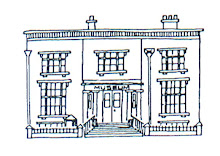Jane Stuart (1654 -1742)
‘Queen of the Reapers’
Wherein lies the truth in the story of Jane Stuart. In the graveyard attached to the Friends’ Meeting House, Wisbech stands a simple headstone with the initials “JS”, and the age and date “88” and 1742”. This is the final resting place of one Jane Stuart, widely acknowledged as a natural daughter of James II, King of England. This is according to folklore written down some thirty years or so after her death by Samuel Peckover, a prominent Cambridgeshire Quaker.
Jane is believed to have been born in Paris, the daughter of James, Duke of York, then in exile. He had escaped England in 1648 when confined to St James’s Palace by Parliamentary Leaders. Jane became a maid of honour to Queen Henrietta Maria and remained at the English Court from the Restoration (1685) to the Glorious Revolution (1688), but she has never been officially recognised. After the Glorious Revolution, Jane escaped the Court and finally found refuge in Wisbech, living a life of simplicity and piety.
Before this, however, there was a further intriguing twist to her story which lead to her being named Queen of the Reapers. Although the Court of James II was Catholic, it is understood that Jane Stuart became influenced by the principles of the Quakers. Like many of similar radical belief, she was imprisoned because of her association with the movement. It was during this period of her life that she became engaged to be married. Tragically a coach in which she and her future husband were travelling overturned and he was killed.
Following this tragedy, Jane remained in London for some time before eventually setting-off on foot towards the Isle of Ely. Presumably penniless, she sought after work and enquired at several houses about employment. When asked what she could do, she answered that she was prepared to set her hand at anything. To which the response was, “Canst thou reap?” She replied that she didn’t know but was willing to try. So she was sent into the field, and before evening she was discovered to be so proficient at reaping as to be called Queen of the reapers. 1
In Wisbech she lived in a basement room in a white house at the far end of the Old Market looking towards the Town Bridge. Today it is more familiar as Granny’s Cupboard. There she supported herself by earning her living reaping in the fields in the summer and spinning wool and flax in the winter. Though she led a humble existence she remained an enigma as a further story suggests that neighbours witnessed her reading the New Testament in Greek.
After the Glorious Revolution the deposed James II fled to France, where the King of France provided him with the use of a chateau at St Germain-en-Laye. Although several Quakers visited James II at St Germain, there is no record of Jane Stuart ever being there; nor did James II, a tender father to his natural children, ever mention her. During the rising of 1715 she is alleged to have hired transport to take her to Scotland to see her half-brother, James III (James Francis Edward). There is no connection between Jane Stuart and a namesake, a widow, who claimed to be a great-granddaughter of James I.
Jane Stuart died in Wisbech on 12 September 1742 and was buried in the Quaker burial-ground there. She was unmarried.
Notes:
1. Fenland Notes and Queries, Volume II, p.178.
Reference sources:
A Note on Jane Stuart by R.W. Ketton-Cremer
Eveline Cruickshanks Oxford Dictionary of National Biography
The Royal Quaker, Mrs. E.B. Tanqueray, London, 1914
Make these consistent:
R.W. Ketton-Cremer, A Note on Jane Stuart. In a journal? Place? Date?
Eveline Cruickshanks, Oxford Dictionary of National Biography.
Mrs E.B. Tanqueray, The Royal Quaker, London, 1914.


